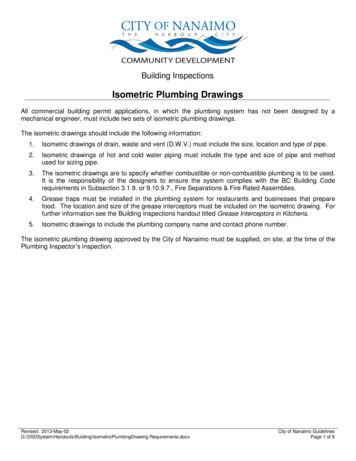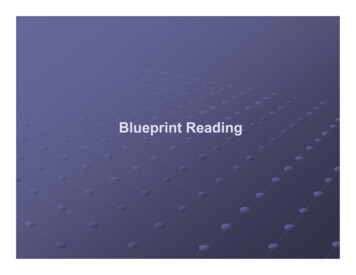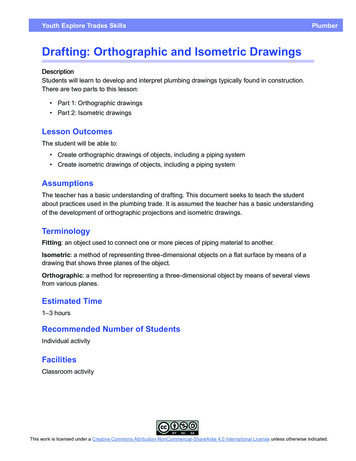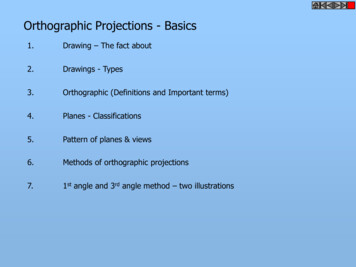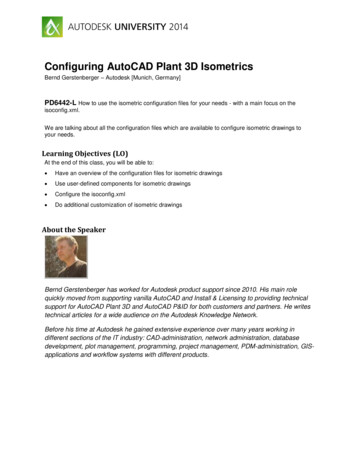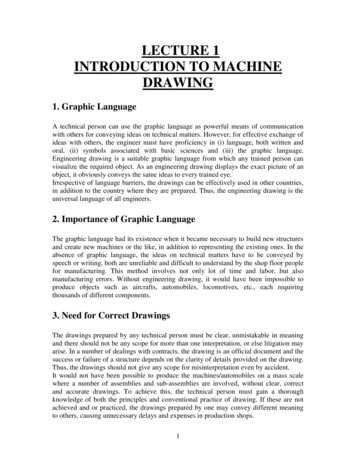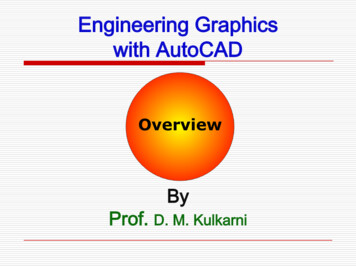
Transcription
Technological DesignMr. WadowskiOrthographic &IsometricDrawing Lesson
TOPICSWorking Drawings,Isometric Drawings &Orthographic DrawingsGlass box conceptMultiview projectionOrthographic projection of point,line, plane, surface and object.Line convention (Themeaning of lines in OrthographicDrawings)
TOPICS (continued)Working DrawingsScaled DrawingsDimensioningDrawing with a MiterLinePractice Worksheets
Working DrawingsThe final stage of illustrating yoursolution is to prepare a set oftechnical illustrations calledWorking Drawings.This set of drawings contains allthe information needed to buildthe product.
Orthographic DrawingsUsed to show details of the front, top and right side viewsUses 3 viewsUsed to provide dimensions and special shapes by usingdifferent line types. For example object, hidden, and centerlines.Draw the front first, top second, and right side lastSpace the views out equally at 40 mmA miter line is used to project details of the object from the topview to the right side view without measuring. Drawnat 45 degrees.
ISOMETRIC DrawingsThree dimensional (3d)You can see how all three views fit togetherAll horizontal lines are angled at 30 degreesand vertical lines remain verticalHidden lines and dimensioning are not shownon Isometric drawings
Orthographic and Isometric
MULTIVIEW PROJECTIONWidthDepthAdjacent view(s)is needed tofulfill the sizedescription.HeightHeight can be presented onlytwo in each view.DepthThree principle dimensionsof an object WidthDepth
TO OBTAIN MULTIVIEWREPRESENTATION OF AN OBJECT1. Revolve the object with respectto observer.2. The observer moves around theobject.
REVOLVE THE OBJECTTop viewFront viewRight side view
OBSERVER MOVE AROUNDTop viewFront viewRight side view
THE GLASS BOX CONCEPTRear viewLeft side viewBottom view
DepthHistoryWidthHeight
OrthographicProjectionof Object Features
OBJECT FEATURESEdgesare lines that represent the boundarybetween two faces.CornersRepresent the intersection of two ormore edges.EdgeCornerEdgeNo cornerNo edgeNo corner
OBJECT FEATURESSurfacesare areas that are bounded by edgesor limiting element.Limitingelementis a line that represents the last visiblepart of the curve surface.SurfaceSurfaceLimitSurfaceLimit
PROJECTION OF LINETrue lengthBTATBTEquallengthATBAAF BFPointBRARAF BFARBRTrue lengthNORMAL LINE
PROJECTION OF LINETrue ortenedForeshortenedINCLINED LINE
PROJECTION OF ARForeshortenedAFARForeshortenedOBLIQUED LINE
PROJECTION OF PLANETrue AF,CFAR,BRCREdgeNORMAL PLANE
PROJECTION OF CRABFAFForeshortenedAR,BREdgeBFAFAR,BRINCLINED PLANE
PROJECTION OF OBJECTThe views are obtained by projecting all objectfeatures to the picture plane.You have to project the remaining surfaces which areinvisible too !
PROJECTION OF OBJECTsss
PROJECTION OF OBJECT
PROJECTION OF TOP VIEW
PROJECTION OF TOP VIEW
PROJECTION OF TOP VIEW
PROJECTION OF TOP VIEW
PROJECTION OF TOP VIEW
PROJECTION OF TOP VIEW
PROJECTION OF TOP VIEW
PROJECTION OF TOP VIEW
PROJECTION OF FRONT VIEW
PROJECTION OF FRONT VIEW
PROJECTION OF FRONT VIEW
PROJECTION OF FRONT VIEW
PROJECTION OF FRONT VIEW
PROJECTION OF FRONT VIEW
PROJECTION OF FRONT VIEW
PROJECTION OF FRONT VIEW
PROJECTION OF FRONT VIEW
PROJECTION OF RIGHT VIEW
PROJECTION OF RIGHT VIEW
PROJECTION OF RIGHT VIEW
PROJECTION OF RIGHT VIEW
PROJECTION OF RIGHT VIEW
PROJECTION OF RIGHT VIEW
Line ConventionThe meaning of lines
LINE CONVENTIONThe meaning of linesPrecedence of coincide linesHidden line drawingCenter line drawing
THE MEANING OF LINESObject Lines
THE MEANING OF LINESHidden Lines
THE MEANING OF LINESCenter LinesThin lines made up
THE MEANING OF LINESDimension Lines
THE MEANING OF LINESExtension Lines
PRECEDENCE OF LINEOrder ofimportanceVisiblelineHiddenlineCenterline
OTHER ARCHITECTURAL LINESHidden Lines
ARCHITECTURAL LINESOther Lines
OBJECT and HIDDEN LINE EXAMPLE
OBJECT, HIDDEN and CENTER LINEEXAMPLEDraw front view first
OBJECT, HIDDEN and CENTER LINEEXAMPLEDraw top view second
OBJECT, HIDDEN and CENTER LINEEXAMPLEDraw right side view last
HIDDEN LINE PRACTICEHidden line should join a visible line, except itextended from the visible line.LeavespaceCorrectJoinNo !
HIDDEN LINE PRACTICEHidden line should join a visible line, except itextended from the visible line.LeavespaceLeavespaceCorrectNo !
HIDDEN LINE PRACTICEHidden line should intersect to form L and Tcorners.LTCorrectNo !
HIDDEN LINE PRACTICEHidden arcs should start on a center line.
HIDDEN LINE PRACTICE
HIDDEN LINE PRACTICE
HIDDEN LINE PRACTICE
HIDDEN LINE PRACTICE
HIDDEN LINE PRACTICE
HIDDEN LINE PRACTICE
HIDDEN LINE PRACTICE
HIDDEN LINE PRACTICE
CENTER LINE PRACTICEIn circular view, short dash should cross at theintersections of center line.For small hole, center line is presented as thincontinuous line.Center line should not extend between views.Leave spaceLeave space
CENTER LINE PRACTICELeave the gap when centerline forms acontinuation with a visible or hidden lineCenter line should always start and end withlong dash.LeavespaceLeavespaceLeavespaceLeavespace
DRAWING USING A MITERLINE
DRAWING USING A MITERLINE
DRAWING USING A MITERLINE
SCALED DRAWINGSObjects must be scaled to fit onto a piece ofdrawing paperThey are exact in every detail but reducedor enlarged in size in direct proportion to theactual objectScale 1:11 mm on drawing paper represents 1mm of the actual object
SCALED DRAWINGSMany objects are too large to be drawn totheir full size. For example an airplane andhouse.Divide /
SCALED DRAWINGSOften it is necessary to produce drawingslarger than full sizeDetails of small objects are clearer andeasier to dimension when they are drawnlarger then their actual sizeMultiply X
TITLE BLOCKA title block is a portion of a drawing thatis set aside to give important informationabout the drawing. The drafter, the scale,the units, and your nameYou must “frame” your drawing to make itlook professional. Draw a 1 cm borderand a 1 cm high area for your title blockA title block template can be found on theshared drive. Ask your teacher.
TITLE BLOCK TEMPLATE
DIMENSIONING DRAWINGS
DIMENSIONING DRAWINGS
DIMENSIONING DRAWINGSAsk your teacher for alist of dimensioningRulesDimensioning lines mustfollow these rules
THE STAGE IS SET FOR YOUTO BECOME AN EXPERTTECHNICAL DRAWERPractice drawingworksheets can befound on the shareddrive
A title block is a portion of a drawing that is set aside to give important information about the drawing. The drafter, the scale, the units, and your name You must “frame” your drawing to make it look professional. Draw a 1 cm border and a 1 cm high area for your title block A title bloc

